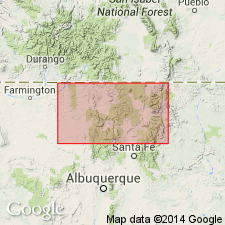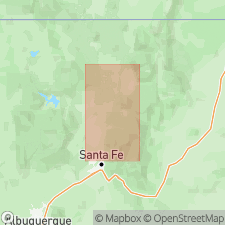
- Usage in publication:
-
- Carson conglomerate
- Modifications:
-
- Original reference
- Dominant lithology:
-
- Conglomerate
- AAPG geologic province:
-
- San Juan basin
Summary:
Pg. 13 (table 1), 31, 48-49, pls. 1, 3. Carson conglomerate. Characteristically coarse, containing many boulders over a foot in diameter. Usually well cemented and quite resistant to processes of denudation. Matrix is light gray and resembles concrete; cement is silica. Boulders, cobbles, and pebbles consist of rhyolite, trachyte, andesite, black chert, and quartzite. Overlaps Precambrian rocks of area. [Age is lower or middle Tertiary.]
[Overlaps rocks of Precambrian age along western, northern, and northeastern
borders of Petaca area, Rio Arriba Co., Carson National Forest area, central northern NM.]
Source: US geologic names lexicon (USGS Bull. 1200, p. 649-650).

- Usage in publication:
-
- Carson conglomerate
- Modifications:
-
- Age modified
- Areal extent
- AAPG geologic province:
-
- San Juan basin
Summary:
Pg. 25. Carson conglomerate. Age is early or middle Tertiary. Best exposures cited.
Best exposed in vicinity of Las Tablas where beds form bold cliffs and benches along lower slopes of Tusas River valley, [Rio Tusas valley, Las Tablas 7.5-min quadrangle, Rio Arriba Co., Carson National Forest area], central northern NM.
Source: US geologic names lexicon (USGS Bull. 1200, p. 649-650).
For more information, please contact Nancy Stamm, Geologic Names Committee Secretary.
Asterisk (*) indicates published by U.S. Geological Survey authors.
"No current usage" (†) implies that a name has been abandoned or has fallen into disuse. Former usage and, if known, replacement name given in parentheses ( ).
Slash (/) indicates name conflicts with nomenclatural guidelines (CSN, 1933; ACSN, 1961, 1970; NACSN, 1983, 2005, 2021). May be explained within brackets ([ ]).

